I cant get the right answer to this problem. Any one please help:
The waiter at a restaurant has noticed that 60% of the couples order dessert and coffee. However, 20% of the couples who order dessert don't order coffee. What is the probability that the next couples the waiter seats will not order dessert?
A) 20%
B) 25%
C) 40%
D) 60%
E) 75%
OA - B
My solution is as follows:
P(D and C) = 60% or 3/5
P(only dessert) = 20% or 1/5
So, P(only coffee) = ????
So, to get P(only coffee), I subtracted P(D and C ) and P(only deserrt) i.e. 1-3/5 = 2/5-1/5 = 1/5 or 20% but the OA is 25%
Dessert and coffee
This topic has expert replies
GMAT/MBA Expert
- Brent@GMATPrepNow
- GMAT Instructor
- Posts: 16207
- Joined: Mon Dec 08, 2008 6:26 pm
- Location: Vancouver, BC
- Thanked: 5254 times
- Followed by:1268 members
- GMAT Score:770
This question is typically best solved using the Double Matrix method, but that method is hard to show in a text format. Since I'm about to watch the Canada/US Olympic hockey game (:-)), I'll provide the text solution (with possible a double matrix approach later in the day, unless someone else provides one) :safina wrote:
The waiter at a restaurant has noticed that 60% of the couples order dessert and coffee. However, 20% of the couples who order dessert don't order coffee. What is the probability that the next couples the waiter seats will not order dessert?
A) 20%
B) 25%
C) 40%
D) 60%
E) 75%
Let's say there are 100 couples altogether.
Let's let x = the total number of couples who order dessert.
Important: (# of couples who order dessert and coffee) + (# of couples who order dessert but no coffee) = total number of people who order dessert
Given: 60 couples order dessert and coffee
Given: 20% of the couples who order dessert don't order coffee
In other words, 20% of x = number of couples who order dessert don't order coffee
So, 0.2x = number of couples who order dessert don't order coffee
So, we get: (60) + (0.2x) = x
Solve... 60 = 0.8x
60/0.8 = x
75 = x
If 75 couples order dessert, then 25 couples do not order dessert (since we said there were 100 couples altogether).
This means that [spoiler]25%[/spoiler] of couples do not order dessert.
Cheers,
Brent
- Patrick_GMATFix
- GMAT Instructor
- Posts: 1052
- Joined: Fri May 21, 2010 1:30 am
- Thanked: 335 times
- Followed by:98 members
Great question Safina. It can be solved in several ways; below are two of them.
Solve with Venn Diagram

Groups Table

Hope that helps,
-Patrick
Solve with Venn Diagram

Groups Table

Hope that helps,
-Patrick
- Check out my site: GMATFix.com
- To prep my students I use this tool >> (screenshots, video)
- Ask me about tutoring.
- GMATGuruNY
- GMAT Instructor
- Posts: 15539
- Joined: Tue May 25, 2010 12:04 pm
- Location: New York, NY
- Thanked: 13060 times
- Followed by:1906 members
- GMAT Score:790
Let total people = 100.safina wrote:I cant get the right answer to this problem. Any one please help:
The waiter at a restaurant has noticed that 60% of the couples order dessert and coffee. However, 20% of the couples who order dessert don't order coffee. What is the probability that the next couples the waiter seats will not order dessert?
A) 20%
B) 25%
C) 40%
D) 60%
E) 75%
We can plug in the answers, which represent the number of people who do not order dessert.
Answer choice C: 40 do not order dessert.
Thus, the total number who order dessert = 60.
Too small.
It is given that the number who order BOTH dessert and coffee = 60.
Since some people order ONLY dessert but not coffee, the TOTAL number who order dessert must be GREATER than 60.
To INCREASE the total number who order dessert, the number who do not order dessert must DECREASE from 40.
Eliminate C, D and E.
Answer choice B: 25 do not order dessert.
Thus, the total number who order dessert = 75.
Since 20% of these people do not order coffee, the number who order dessert but not coffee = (.2)*75 = 15.
Thus, number who order BOTH dessert and coffee = (total who order dessert) - (number who order dessert but not coffee) = 75-15 = 60.
Success!
The correct answer is B.
Private tutor exclusively for the GMAT and GRE, with over 20 years of experience.
Followed here and elsewhere by over 1900 test-takers.
I have worked with students based in the US, Australia, Taiwan, China, Tajikistan, Kuwait, Saudi Arabia -- a long list of countries.
My students have been admitted to HBS, CBS, Tuck, Yale, Stern, Fuqua -- a long list of top programs.
As a tutor, I don't simply teach you how I would approach problems.
I unlock the best way for YOU to solve problems.
For more information, please email me (Mitch Hunt) at [email protected].
Student Review #1
Student Review #2
Student Review #3
Followed here and elsewhere by over 1900 test-takers.
I have worked with students based in the US, Australia, Taiwan, China, Tajikistan, Kuwait, Saudi Arabia -- a long list of countries.
My students have been admitted to HBS, CBS, Tuck, Yale, Stern, Fuqua -- a long list of top programs.
As a tutor, I don't simply teach you how I would approach problems.
I unlock the best way for YOU to solve problems.
For more information, please email me (Mitch Hunt) at [email protected].
Student Review #1
Student Review #2
Student Review #3
GMAT/MBA Expert
- Brent@GMATPrepNow
- GMAT Instructor
- Posts: 16207
- Joined: Mon Dec 08, 2008 6:26 pm
- Location: Vancouver, BC
- Thanked: 5254 times
- Followed by:1268 members
- GMAT Score:770
Here's another way to set up the Double Matrix.safina wrote:
The waiter at a restaurant has noticed that 60% of the couples order dessert and coffee. However, 20% of the couples who order dessert don't order coffee. What is the probability that the next couples the waiter seats will not order dessert?
A) 20%
B) 25%
C) 40%
D) 60%
E) 75%
Before showing this, I'll mention that the Double Matrix Method can be used for most questions featuring a population in which each member has two characteristics associated with it.
Here, we have a population of couples, and the two characteristics are:
- dessert or no dessert
- coffee or no coffee
So, we can begin my setting up our diagram as follows:
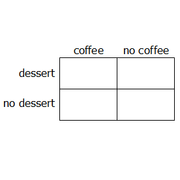
NOTICE that the question does not ask us to find the actual number of couples who didn't have dessert. It asks us to find a probability. This means we can assign whatever value we wish to the total number of couples.
So, let's say there are 100 couples and add this to our diagram:
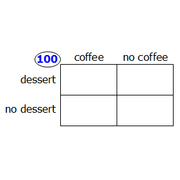
60% of the couples order dessert and coffee
60% of 100 = 60, so 60 couples order dessert AND coffee.
Add that to the diagram to get:
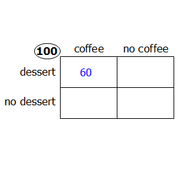
20% of the couples who order dessert don't order coffee.
Hmmm, we don't know how many couples order dessert, so it's hard to find 20% of that value.
So, let's assign a variable.
Let's let x = number of couples who order dessert, and add it to our diagram:
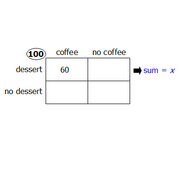
So, x of the 100 couples order dessert.
20% of the couples who order dessert don't order coffee.
If x couples order dessert, then 20% of x don't order coffee.
In other words, 0.2x = number of couples don't order coffee.
Add this to our diagram:
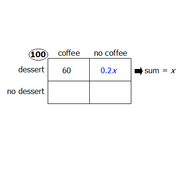
At this point, we see that the top two boxes add to x.
So, we can write the equation: 60 + 0.2x = x
Rearrange to get 60 = 0.8x
Rewrite 0.8 as fraction to get: 60 = (4/5)x
Multiply both sides by 5/4 to get: 75 = x
If x = 75, then we know that 75 of the 100 couples order dessert:
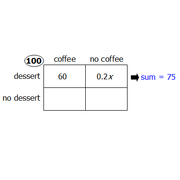
This means that 25 of the 100 couples DON'T order dessert:
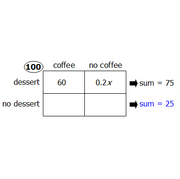
So, P(couple doesn't order dessert) = 25/100 = 25% = B
Cheers,
Brent
---------------------------------------------------------
To learn more about this technique, watch our free video: https://www.gmatprepnow.com/module/gmat- ... ems?id=919
Once you're familiar with the Double Matrix Method, you can attempt these additional practice questions:
Easy Problem Solving questions
- https://www.beatthegmat.com/the-aam-aadm ... 72242.html
- https://www.beatthegmat.com/finance-majo ... 67425.html
Medium Problem Solving questions
- https://www.beatthegmat.com/probability- ... 73360.html
- https://www.beatthegmat.com/posted-speed ... 72374.html
- https://www.beatthegmat.com/motel-t271938.html
- https://www.beatthegmat.com/of-the-appli ... 70255.html
- https://www.beatthegmat.com/opening-nigh ... 64869.html
- https://www.beatthegmat.com/ds-french-ja ... 22297.html
Difficult Problem Solving questions
- https://www.beatthegmat.com/ratio-problem-t268339.html
- https://www.beatthegmat.com/overlapping- ... 65223.html
- https://www.beatthegmat.com/fractions-t264254.html
- https://www.beatthegmat.com/overlapping- ... 64092.html
- https://www.beatthegmat.com/mba/2011/05/ ... question-2
Easy Data Sufficiency questions
- https://www.beatthegmat.com/for-what-per ... 70596.html
- https://www.beatthegmat.com/ds-quest-t187706.html
Medium Data Sufficiency questions
- https://www.beatthegmat.com/sets-matrix-ds-t271914.html
- https://www.beatthegmat.com/each-of-peop ... 71375.html
- https://www.beatthegmat.com/a-manufacturer-t270331.html
- https://www.beatthegmat.com/in-costume-f ... 69355.html
- https://www.beatthegmat.com/mba/2011/05/ ... question-1
Difficult Data Sufficiency questions
- https://www.beatthegmat.com/double-set-m ... 71423.html
- https://www.beatthegmat.com/sets-t269449.html
- https://www.beatthegmat.com/mba/2011/05/ ... question-3




















